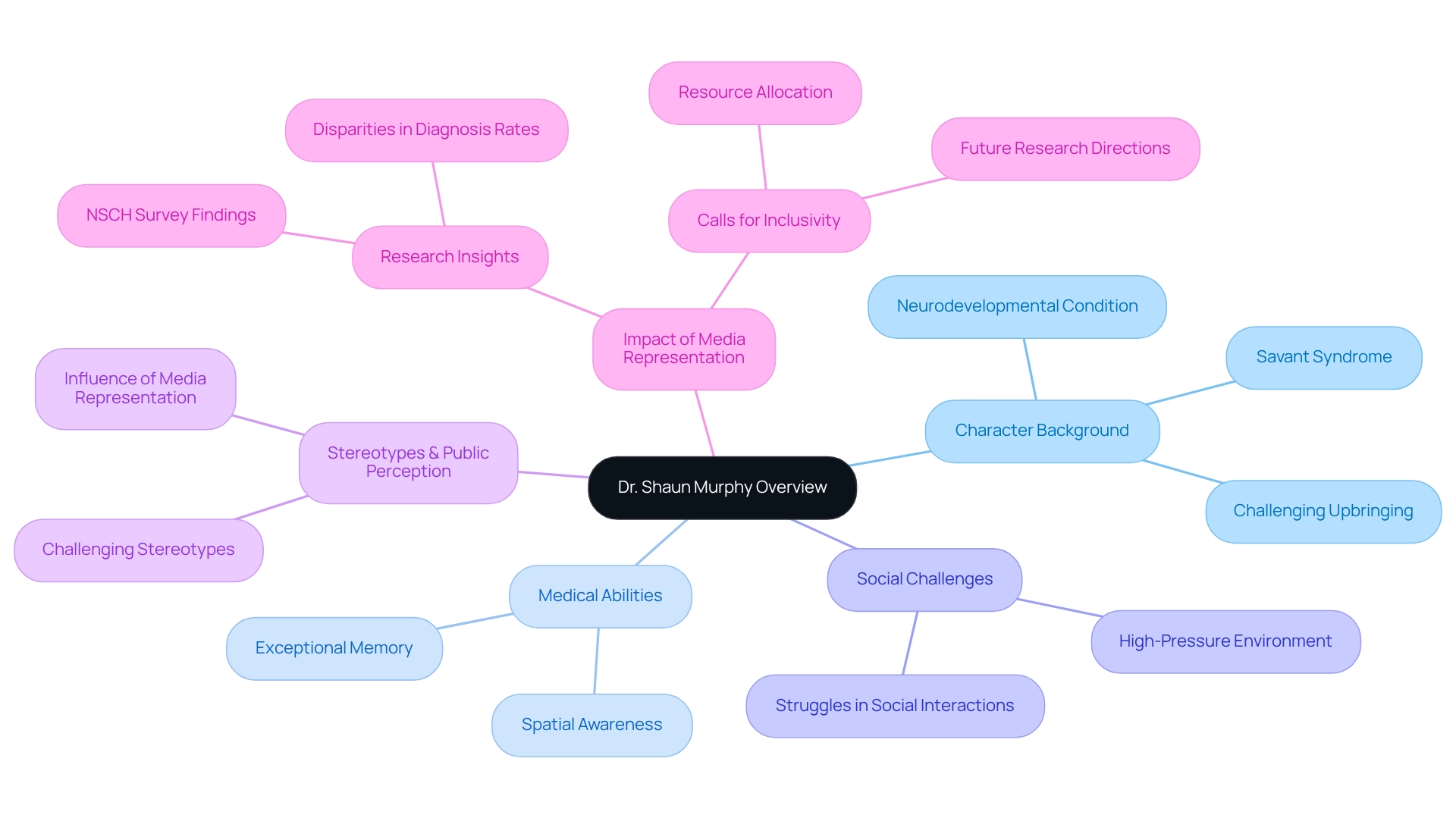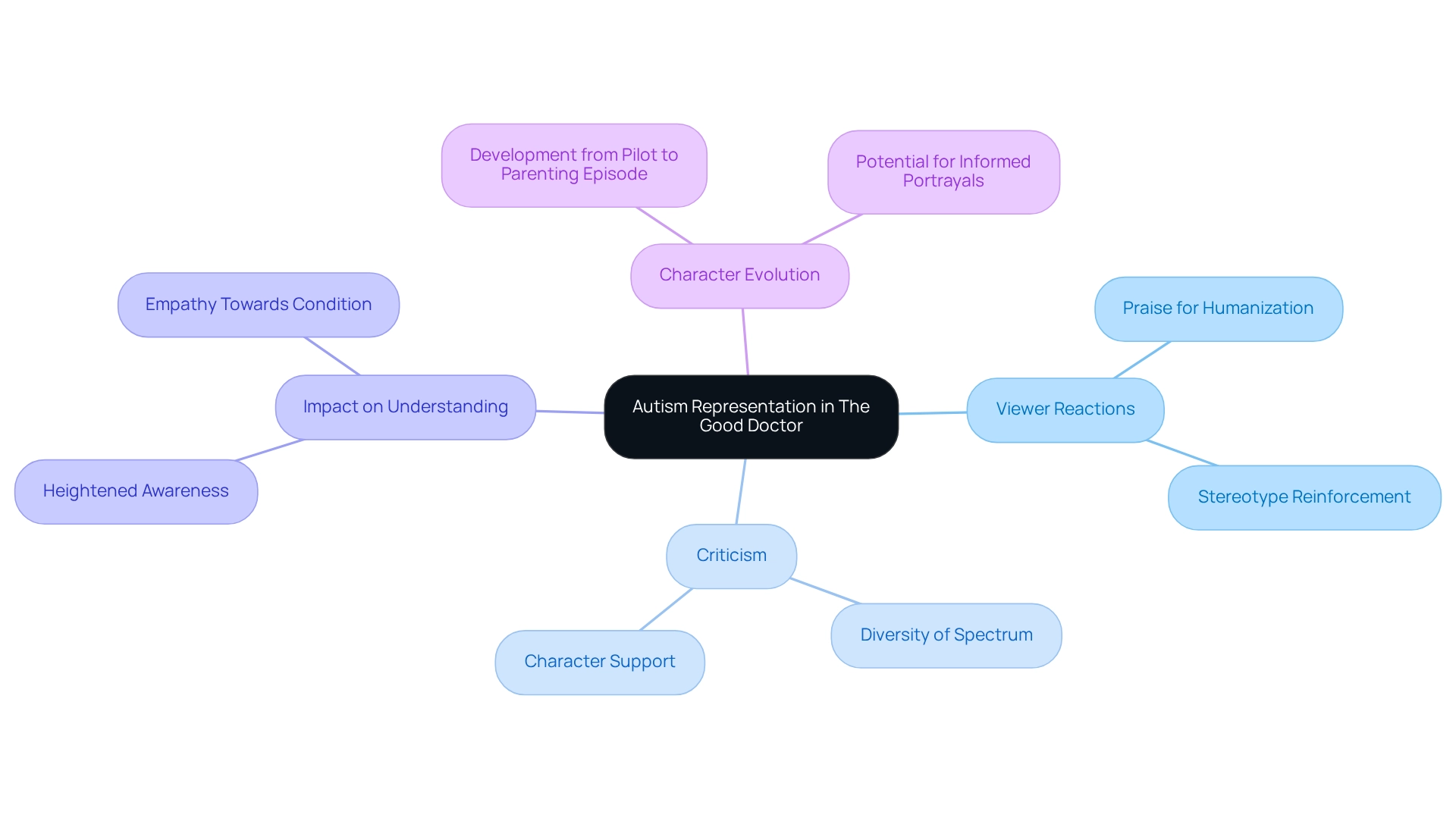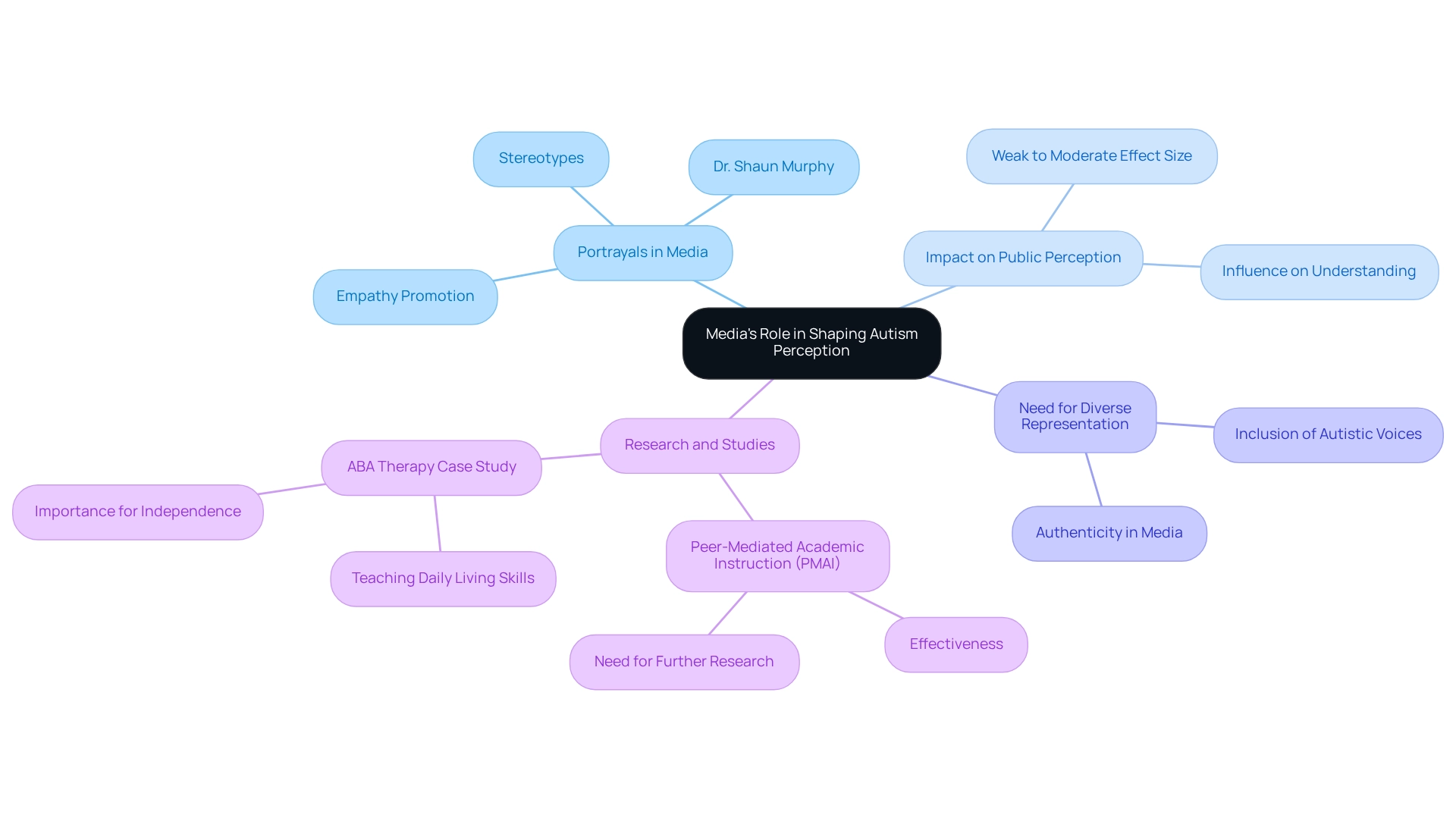Overview
This article thoughtfully examines whether Dr. Shaun Murphy, a character from "The Good Doctor" portrayed by Freddie Highmore, truly represents the autism community. It delves into the complexities of his character, highlighting both his impressive medical skills and the personal challenges he faces. However, it raises an important concern: does his portrayal unintentionally reinforce stereotypes? This question invites us to reflect on the broader implications of autism representation in media.
As we consider the character's journey, it's essential to recognize the need for more accurate and diverse portrayals of autism. Such representations can significantly enhance understanding and empathy within society. By sharing stories that resonate with real experiences, we can create a more inclusive narrative that reflects the richness of the autism spectrum.
Let us come together to advocate for change in how autism is depicted in media. By fostering a deeper understanding and encouraging diverse voices, we can cultivate a more compassionate society that values every individual's unique story. Your thoughts and experiences are vital to this conversation—please share them in the comments or through our newsletter, as we strive for a more inclusive representation of autism.
Introduction
In the realm of television, few characters have sparked as much conversation as Dr. Shaun Murphy from 'The Good Doctor.' Portrayed by Freddie Highmore, this young surgical resident embodies a unique intersection of autism and savant syndrome, showcasing extraordinary medical abilities while navigating the complexities of social interactions. This portrayal invites us to reflect on the challenges faced by individuals on the autism spectrum, particularly in social settings.
As the series unfolds, it not only entertains but also challenges societal stereotypes about autism, offering a nuanced portrayal that resonates deeply with audiences. This article delves into the multifaceted representation of autism in 'The Good Doctor,' examining both its strengths and limitations. It highlights the critical role media plays in shaping public perceptions and understanding.
Through an exploration of Dr. Murphy's journey, we are invited to engage in a broader dialogue about neurodiversity and the importance of authentic representation in media. Let us come together to foster understanding and support for all individuals, encouraging a more inclusive narrative.
Define Dr. Shaun Murphy: Character Overview and Background
Dr. Shaun Murphy, portrayed by Freddie Highmore, is a young surgical resident at the fictional San Jose St. Bonaventure Hospital. His life is shaped by a neurodevelopmental condition and savant syndrome, leading many to wonder if the good doctor actor is really autistic, a combination that grants him remarkable medical abilities, especially in spatial awareness and memory. These skills enable him to thrive in a demanding medical environment, yet his journey is not without its hurdles. He faces difficulties in social interactions and the pressures that come with such a high-stakes profession.
Developed by David Shore, the question of whether is the good doctor actor really autistic arises as Dr. Murphy's character serves as a powerful narrative tool to challenge existing stereotypes about developmental disorders. His story showcases not only his extraordinary professional capabilities but also his personal struggles, inviting viewers to connect with him on a deeper level. His challenging upbringing adds significant depth to his character, illuminating the complexities of living with a developmental condition. This portrayal resonates with audiences and fosters a broader understanding of such conditions in society, raising the question of whether the good doctor actor is really autistic.
Recent research indicates that media representations like Dr. Murphy's can profoundly influence public perceptions of developmental disorders. The NSCH survey highlights disparities in diagnosis rates among various demographic groups, underscoring the need for inclusivity that reflects these realities. Melody Cooper's poignant observation that 'having an intellectual disability does not mean you’re dumb; they work harder than most just to do things others take for granted' adds an emotional dimension to this discussion, reinforcing both the character's portrayal and the larger implications for understanding developmental differences.
Additionally, the case study titled "Utilization of Administrative Health Data for ASD Research" demonstrates how data can be instrumental in examining trends in diagnosis rates. This calls for future studies to address inclusivity limitations. By emphasizing Dr. Murphy's strengths alongside his challenges, the series encourages a deeper understanding and compassion, ultimately fostering a more informed conversation about developmental conditions and their representation in entertainment. Let’s continue to support narratives that promote awareness and empathy, paving the way for a more inclusive society.

Examine Autism Representation in 'The Good Doctor': Accuracy and Impact
The portrayal of the condition in 'The Good Doctor' has sparked significant discussion among viewers and advocates for the cause, particularly about whether the good doctor actor is really autistic. This series has not only received acclaim for highlighting the condition within mainstream media but has also faced criticism about whether the good doctor actor is really autistic. Critics contend that Dr. Shaun Murphy, who is the good doctor actor, does not fully represent the spectrum's diversity despite exhibiting certain autistic traits. His savant abilities, for instance, risk reinforcing the stereotype that all autistic individuals possess extraordinary skills.
However, many viewers praise the show for humanizing the condition, presenting Dr. Murphy as a skilled professional, which raises the question, is the good doctor actor really autistic? This nuanced portrayal encourages greater understanding and acceptance of individuals with neurodevelopmental differences, fostering essential conversations about neurodiversity in society. Recent statistics suggest that representations like Dr. Murphy's, where the question of whether the good doctor actor is really autistic arises, can greatly impact public perception, with many viewers noting heightened awareness and empathy towards the condition as a result of the show.
Moreover, professional insights highlight the significance of precise portrayal in media, indicating that while 'The Good Doctor' advances visibility, there exists a vital necessity for ongoing improvement in genuinely illustrating the diverse experiences of individuals on the spectrum, including whether the good doctor actor is really autistic. As David insightfully remarked, "I have a strong, supportive family, and this character has none," emphasizing the vital role of family support in the context of developmental disorder awareness.
Furthermore, Courtney Weaver's comments on Dr. Murphy's character evolution from the pilot to the 'Parenting' episode indicate a possibility for more informed portrayals of the condition. This further highlights the necessity for continual discussion and enhancement in how it is depicted.

The Role of Media in Shaping Perceptions of Autism
Media plays a crucial role in shaping public perceptions of autism, particularly when it comes to whether the good doctor actor really autistic, like Dr. Shaun Murphy from 'The Good Doctor,' serves as a double-edged sword. While such portrayals can clarify the condition and challenge common misconceptions, they often provide a restricted perspective by concentrating on highly functional yet socially awkward characters. This narrow portrayal risks reinforcing stereotypes rather than encouraging a comprehensive understanding of the spectrum of autism-related conditions.
Experts stress the significance of varied inclusion in media, advocating for the presence of autistic voices in content creation. This method not only improves authenticity but also mirrors the diverse experiences within the neurodiverse community. Favorable portrayals can significantly influence societal attitudes, promoting empathy and acceptance among viewers.
Data shows that media depictions can influence public comprehension of autism spectrum conditions, with research suggesting a weak to moderate effect size in how these portrayals affect views. A study highlighted by Marcus Fuller states, "These results validate PMAI can be effective when teaching academic skills to students with ASD; however, more studies are needed to better understand for whom and under what conditions PMAI is most effective." Recent conversations, including a news article from April 22, 2025, highlight the need for additional research to investigate the effectiveness of peer-mediated academic instruction (PMAI) in educational environments for students with spectrum disorders.
Additionally, a case study titled "How ABA Therapy Teaches Daily Living Skills" explores how ABA therapy is utilized to teach essential daily living skills, underscoring the importance of these skills for independence and quality of life. As the media environment changes, it is essential to emphasize varied and precise portrayals to enhance the narrative regarding developmental disorders. Together, we can work towards creating a more educated and empathetic community.

Challenges and Opportunities in Autism Representation
Despite advancements in representation for individuals on the spectrum, significant challenges persist. A primary concern is the underrepresentation of autistic individuals in writing and production roles, which often results in misrepresentations and oversimplifications of the autistic experience. The inclination to highlight savant skills can obscure the daily challenges encountered by many individuals on the spectrum, resulting in a limited depiction of the condition.
However, there are promising opportunities for improvement. By enhancing cooperation with autistic advisors and embracing varied stories, media can improve representations and provide a more detailed comprehension of the condition. For instance, shows like 'The Good Doctor' can act as catalysts for dialogue, especially when discussing whether the good doctor actor is really autistic and encouraging creators to delve into the full spectrum of autism and its varied experiences.
Statistics show that 17% of children aged 3–17 years were diagnosed with a developmental disability from 2009 to 2017, emphasizing the importance of precise portrayal in media to reflect the realities of a significant portion of the population. As Jim Hogan, Principal Innovation Strategist at Google and Autism Spectrum Award Winner, states, "my activism is not about ending Autism, it is about ending cruelty," emphasizing the need for genuine portrayal to combat the bullying and misunderstanding that often accompany misrepresentation.
Additionally, effective partnerships with autistic consultants, like those observed in different television productions, have shown that genuine inclusion can result in more relatable and precise portrayals, ultimately promoting greater awareness and understanding.
The Impact of 'The Good Doctor' on Autism Awareness
The Good Doctor' has played a pivotal role in raising awareness about neurodevelopmental disorders, including discussions on whether the good doctor actor is really autistic, and sparking important conversations about the unique challenges and strengths of individuals on the spectrum. Many viewers report a deepened sense of empathy and understanding towards autistic individuals after watching the show, which raises the question of whether the good doctor actor is really autistic. Dr. Shaun Murphy, who is the good doctor actor really autistic, is portrayed as a competent and resilient character, standing as a powerful symbol that challenges prevalent stereotypes in media portrayals.
Yet, it is crucial to acknowledge that the series has faced criticism for its limited representation of the diversity within the spectrum. Alarmingly, autistic children are twice as likely to express suicidal thoughts compared to their non-autistic peers, highlighting the urgent need for accurate portrayals in media. As this discussion unfolds, it becomes essential for media creators to listen to feedback from the neurodiverse community, ensuring that future representations are both accurate and inclusive.
Dr. Carrie Alvarado, Chief Operating Officer of the Autism Community Network, reminds us that 'Your child can still have a very meaningful life,' reinforcing the potential for positive outcomes. Additionally, a case study titled 'Hope and Growth in Language Development for Autistic Children' demonstrates that many children with severe language delays can eventually acquire language skills, offering hope for families. This approach not only enhances public understanding but also contributes to fostering a more empathetic society, aligning with ongoing advocacy efforts within the neurodiversity community.
For further information on autism diagnosis, the Autism Community Network serves as a valuable resource.
Conclusion
Dr. Shaun Murphy's character in 'The Good Doctor' serves as a significant catalyst for conversations around autism, bringing forth both commendable representation and critical scrutiny. His journey effectively highlights the unique challenges and exceptional abilities of individuals on the autism spectrum. While the portrayal has been praised for humanizing autism and fostering empathy, it also raises important discussions about the diversity within the spectrum and the potential reinforcement of stereotypes, particularly regarding savant abilities.
The impact of media representation cannot be overstated; it plays a pivotal role in shaping public perceptions of autism. Accurate and nuanced portrayals can enhance understanding and acceptance, while oversimplified depictions risk perpetuating misconceptions. As the media landscape evolves, the inclusion of autistic voices in content creation is essential for fostering authenticity and reflecting the varied experiences within the autism community.
Despite the strides made in autism representation, challenges remain, particularly regarding the underrepresentation of autistic individuals behind the scenes. However, opportunities for growth exist through collaboration with autistic consultants and a commitment to portraying the full spectrum of autism. As 'The Good Doctor' continues to evolve, it has the potential to inspire further dialogue and understanding, ultimately contributing to a more informed and compassionate society. Embracing diverse narratives will not only enrich storytelling but also empower individuals on the autism spectrum, ensuring their experiences are authentically represented and understood.
Frequently Asked Questions
Who is Dr. Shaun Murphy and what is his background?
Dr. Shaun Murphy, portrayed by Freddie Highmore, is a young surgical resident at the fictional San Jose St. Bonaventure Hospital. He has a neurodevelopmental condition and savant syndrome, which contribute to his remarkable medical abilities, particularly in spatial awareness and memory.
Does the character of Dr. Shaun Murphy challenge stereotypes about developmental disorders?
Yes, Dr. Murphy's character serves as a powerful narrative tool to challenge existing stereotypes about developmental disorders by showcasing his extraordinary professional capabilities alongside his personal struggles, thereby inviting viewers to connect with him on a deeper level.
How does Dr. Shaun Murphy's character impact public understanding of developmental disorders?
The portrayal of Dr. Murphy can profoundly influence public perceptions of developmental disorders, fostering a broader understanding and empathy towards individuals with such conditions.
What criticisms have been made regarding the portrayal of autism in 'The Good Doctor'?
Critics argue that Dr. Shaun Murphy does not fully represent the diversity of the autism spectrum and that his savant abilities risk reinforcing the stereotype that all autistic individuals possess extraordinary skills.
How do viewers generally respond to Dr. Murphy's character?
Many viewers praise the show for humanizing the condition and presenting Dr. Murphy as a skilled professional, which encourages greater understanding and acceptance of neurodevelopmental differences.
What is the significance of accurate representation in media regarding autism?
Accurate portrayal is crucial as it advances visibility for individuals on the spectrum, but there is a need for ongoing improvement in genuinely illustrating the diverse experiences of autistic individuals.
How has Dr. Murphy's character evolved throughout the series?
Dr. Murphy's character evolution, noted from the pilot to later episodes, indicates potential for more informed portrayals of autism, highlighting the necessity for continual discussion and enhancement in representation.
What role does family support play in the context of developmental disorders as depicted in the series?
Family support is emphasized as vital in the context of developmental disorder awareness, as noted by David, who remarked that his character lacks strong family support, contrasting with his own experience.




